Network Theory: An Overview | Network Theory (Electric Circuits) - Electrical Engineering (EE) PDF Download
| Table of contents |

|
| Basic Terminology |

|
| 1. Electric Circuit |

|
| 2. Electric Network |

|
| 3. Current |

|
| 4. Voltage |

|
| 5. Power |

|
| Types of Network Elements |

|
| Examples |

|
Network theory is the study of solving the problems of electric circuits or electric networks. In this introductory EduRev document, let us first discuss the basic terminology of electric circuits and the types of network elements.
Basic Terminology
In Network Theory, we will frequently come across the following terms:
- Electric Circuit
- Electric Network
- Current
- Voltage
- Power
So, it is imperative that we gather some basic knowledge on these terms before proceeding further. Let’s start with Electric Circuit.
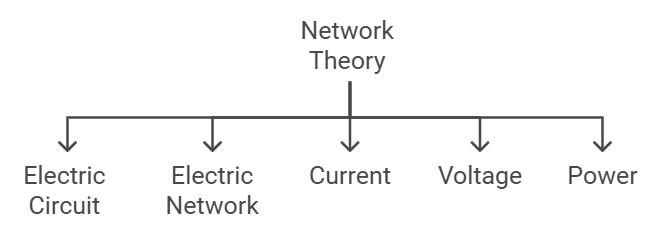
1. Electric Circuit
An electric circuit contains a closed path for providing a flow of electrons from a voltage source or current source. The elements present in an electric circuit will be in series connection, parallel connection, or in any combination of series and parallel connections.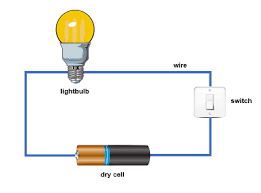
2. Electric Network
An electric network need not contain a closed path for providing a flow of electrons from a voltage source or current source. Hence, we can conclude that "all electric circuits are electric networks" but the converse need not be true.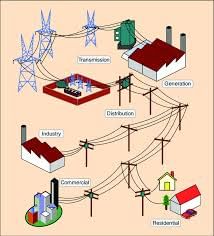
3. Current
The current "I" flowing through a conductor is nothing but the time rate of flow of charge. Mathematically, it can be written as
I = dQ/dt
Where,
- Q is the charge and its unit is Coloumb.
- t is the time and its unit is second.
As an analogy, electric current can be thought of as the flow of water through a pipe. Current is measured in terms of Ampere.
In general, Electron current flows from negative terminal of source to positive terminal, whereas, Conventional current flows from positive terminal of source to negative terminal.
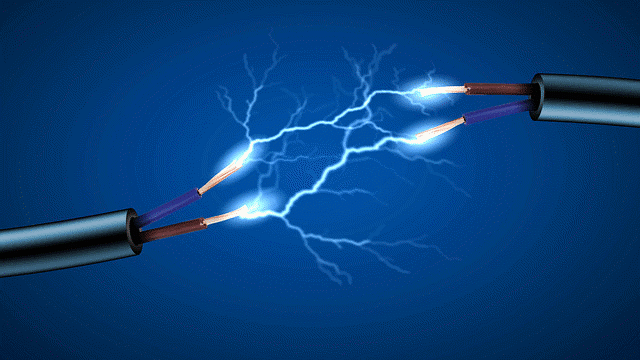 Electron current is obtained due to the movement of free electrons, whereas, Conventional current is obtained due to the movement of free positive charges. Both of these are called as electric current.
Electron current is obtained due to the movement of free electrons, whereas, Conventional current is obtained due to the movement of free positive charges. Both of these are called as electric current.
4. Voltage
The voltage "V" is nothing but an electromotive force that causes the charge (electrons) to flow. Mathematically, it can be written as
V = dW/dQ
Where,
- W is the potential energy and its unit is Joule.
- Q is the charge and its unit is Coloumb.
As an analogy, Voltage can be thought of as the pressure of water that causes the water to flow through a pipe. It is measured in terms of Volt.
5. Power
The power "P" is nothing but the time rate of flow of electrical energy. Mathematically, it can be written as
P = dW/dt
Where,
- W is the electrical energy and it is measured in terms of Joule.
- t is the time and it is measured in seconds.
We can re-write the above equation as
Therefore, power is nothing but the product of voltage V and current I. Its unit is Watt.
Types of Network Elements
We can classify the Network elements into various types based on some parameters. Following are the types of Network elements:
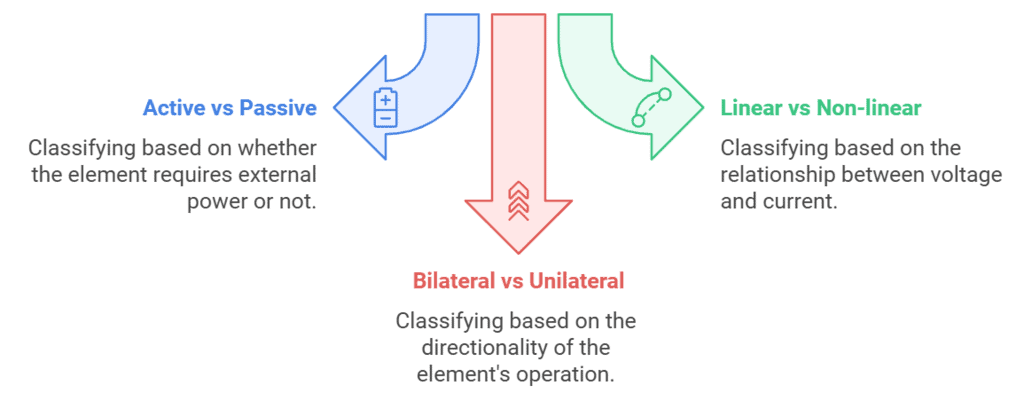
1. Active Elements and Passive
Elements We can classify the Network elements into either active or passive based on the ability of delivering power.
- Active Elements deliver power to other elements, which are present in an electric circuit. Sometimes, they may absorb the power like passive elements. That means active elements have the capability of both delivering and absorbing power.
Examples: Voltage sources and current sources.
- Passive Elements can’t deliver power (energy) to other elements, however they can absorb power. That means these elements either dissipate power in the form of heat or store energy in the form of either magnetic field or electric field.
Examples: Resistors, Inductors, and capacitors.
 |
Download the notes
Network Theory: An Overview
|
Download as PDF |
2. Linear Elements and Non-Linear Elements
We can classify the network elements as linear or non-linear based on their characteristic to obey the property of linearity.
- Linear Elements are the elements that show a linear relationship between voltage and current.
Examples: Resistors, Inductors, and capacitors.
- Non-Linear Elements are those that do not show a linear relation between voltage and current.
Examples: Voltage sources and current sources.
3. Bilateral Elements and Unilateral Elements
Network elements can also be classified as either bilateral or unilateral based on the direction of current flows through the network elements.
(a) Bilateral Elements are the elements that allow the current in both directions and offer the same impedance in either direction of current flow. Examples: Resistors, Inductors and capacitors.
The concept of Bilateral elements is illustrated in the following figures.
In the above figure, the current (I) is flowing from terminals A to B through a passive element having impedance of Z Ω. It is the ratio of voltage (V) across that element between terminals A & B and current (I).
In the above figure, the current (I) is flowing from terminals B to A through a passive element having impedance of Z Ω. That means the current (–I) is flowing from terminals A to B. In this case too, we will get the same impedance value, since both the current and voltage having negative signs with respect to terminals A & B.
(b) Unilateral Elements are those that allow the current in only one direction. Hence, they offer different impedances in both directions.
Examples
We discussed the types of network elements in the previous chapter. Now, let us identify the nature of network elements from the V-I characteristics given in the following examples.
Example 1:
The V-I characteristics of a network element is shown below.
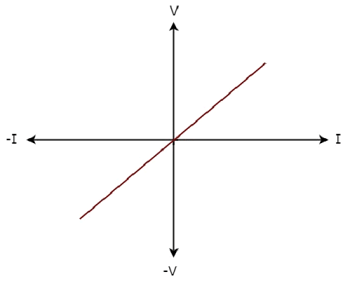

Step 1 − Verifying the network element as linear or non-linear.
From the above figure, the V-I characteristics of a network element is a straight line passing through the origin. Hence, it is a Linear element.
Step 2 − Verifying the network element as active or passive.
The given V-I characteristics of a network element lies in the first and third quadrants.
Since, the given V-I characteristics offer positive impedance values, the network element is a Passive element.
Step 3 − Verifying the network element as bilateral or unilateral.
For every point (I, V) on the characteristics, there exists a corresponding point (-I, -V) on the given characteristics. Hence, the network element is a Bilateral element.
Therefore, the given V-I characteristics show that the network element is a Linear, Passive, and Bilateral element.
Example 2:
The V-I characteristics of a network element is shown below.
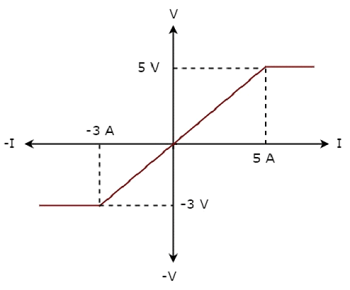
Step 1 − Verifying the network element as linear or non-linear.
From the above figure, the V-I characteristics of a network element is a straight line only between the points (-3A, -3V) and (5A, 5V). Beyond these points, the V-I characteristics are not following the linear relation. Hence, it is a Non-linear element.
Step 2 − Verifying the network element as active or passive.
The given V-I characteristics of a network element lies in the first and third quadrants. In these two quadrants, the ratios of voltage (V) and current (I) produce positive impedance values. Hence, the network element is a Passive element.
Step 3 − Verifying the network element as bilateral or unilateral.
A bilateral element shows the same V-I characteristics in both directions of current flow, while a unilateral element does not. In the provided V-I graph, the point (5A, 5V) corresponds symmetrically to the point (-3A, -3V), indicating that the characteristics are identical in both directions. Therefore, the network element is a Bilateral element.
Final Conclusion: Based on the V-I characteristics, the network element is a Non-linear, Passive, and Bilateral element.
|
73 videos|102 docs|62 tests
|
FAQs on Network Theory: An Overview - Network Theory (Electric Circuits) - Electrical Engineering (EE)
| 1. What is an electric circuit and how does it function? |  |
| 2. What is the difference between an electric circuit and an electric network? |  |
| 3. What is current in an electrical context? |  |
| 4. How are voltage and power related in an electric circuit? |  |
| 5. What are some common types of network elements in electrical circuits? |  |



















